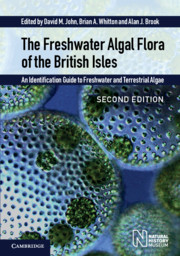 The Freshwater Algal Flora of the British Isles
The Freshwater Algal Flora of the British Isles Published online by Cambridge University Press: 12 January 2024
The chrysophytes (‘Golden Algae’) constitute a group consisting mainly of the classes Chrysophyceae and Synurophyceae. They have in common their unequal flagella (a long hairy flagellum and a short smooth one) and pigment composition with the brown fucoxanthin giving the chloroplasts the characteristic golden-brown colour. They form specific resting stages, stomatocysts, which have a silicified wall with a pore closed by a non-silicified stopper. The two classes diverge in the position of the flagella, chlorophyll composition, and in the way the silica scales are formed. Another class, the Phaeothamniophyceae, includes most coccoid and filamentous forms previously assigned to the Chrysophyceae (i.e. Phaeothamnion, Stichogloea), but these genera are still retained in the Chrysophyceae here. The small class Dictyochophyceae is represented by the radially symmetric pedinellids.
The chrysophytes number about 1000 species. Most are unicellular or colonial flagellates, predominantly occurring in freshwater plankton. This treatment includes about 120 species found in the British Isles. Most of the silica-scaled forms (family Paraphysomonadaceae and the class Synurophyceae require electron microscopy for identification and are not included; only treated are those species which can be identified by means of the light microscope).
Some genera include representatives that are not only phototrophic, but phagotrophic. Sometimes remnants of engulfed organisms are visible.
1 Cells with radial symmetry; single flagellum surrounded by tentacles…………………………… Class Dictyochophyceae, Order Pedinellales (p. 240)
1 Cells not radially symmetrical……………………….. 2
2 Silica scales always present, not differentiated into spine scales and plate scales ……………………………..…..Class Synurophyceae, Order Synurales (p. 310)
2 Silica scales mostly absent, if present then having spine scales and/or plate scales ………………………. 3
3 Mostly flagellated forms with a single or pair of visible flagella, but also amoeboid forms, forms with gelatinous envelopes or with walls, or filamentous forms…………… Class Chrysophyceae, Orders Chromulinales and Hibberdiales (p. 281)
3 Cells arranged in crustose or bushy thalli …………. …. Class Chrysophyceae, Order Hydrurales (p. 308)
DOUBTFUL TAXON
Microglena butcheri J.H.Belcher 1966
Pl. 72I (p. 284)
The position of the genus is problematical and on the basis of electron microscope investigations (Coute´ and Preisig, 1981) it might belong perhaps to the Raphidophyta rather than to the Chrysophyta. This species is characterized by its thick periplast with small lenticular bodies. It has a single yellowish green chloroplast with an eyespot and a funnel-shaped, non-contractile reservoir behind which the large nucleus is located.
To save this book to your Kindle, first ensure [email protected] is added to your Approved Personal Document E-mail List under your Personal Document Settings on the Manage Your Content and Devices page of your Amazon account. Then enter the ‘name’ part of your Kindle email address below. Find out more about saving to your Kindle.
Note you can select to save to either the @free.kindle.com or @kindle.com variations. ‘@free.kindle.com’ emails are free but can only be saved to your device when it is connected to wi-fi. ‘@kindle.com’ emails can be delivered even when you are not connected to wi-fi, but note that service fees apply.
Find out more about the Kindle Personal Document Service.
To save content items to your account, please confirm that you agree to abide by our usage policies. If this is the first time you use this feature, you will be asked to authorise Cambridge Core to connect with your account. Find out more about saving content to Dropbox.
To save content items to your account, please confirm that you agree to abide by our usage policies. If this is the first time you use this feature, you will be asked to authorise Cambridge Core to connect with your account. Find out more about saving content to Google Drive.